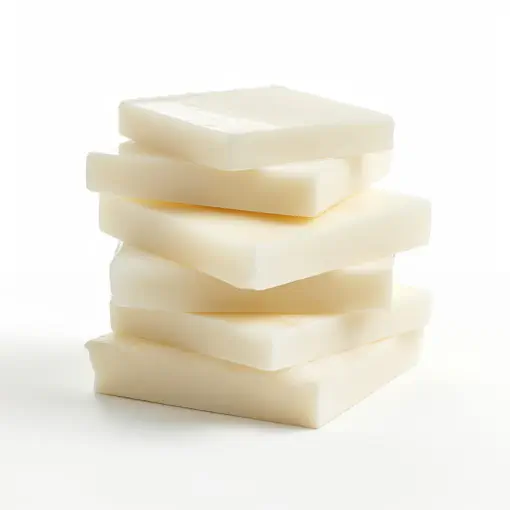Paraffin wax is a widely used type of wax that is derived from petroleum, a non-renewable resource. It is a popular choice for candle making and is also utilized in various other applications, such as in cosmetics, food packaging, and industrial uses.
Paraffin wax is created through the refining process of crude oil. It is a white, translucent solid that can be easily melted into a liquid form for use. Paraffin wax has a high melting point, which allows candles made from it to have a long burning time.
One of the advantages of paraffin wax is its affordability and widespread availability. It is often less expensive compared to other types of waxes, making it a cost-effective option for candle manufacturers and other industries.
Paraffin wax candles can have excellent scent throw, allowing them to disperse and emit fragrance effectively when burned. They are known for producing relatively bright and steady flames, providing a warm and cozy ambiance.
Grades and applications
Here are various grades of paraffin wax available, each with its own specific characteristics and applications. Here are some common grades of paraffin wax:
-
Fully Refined Paraffin Wax:
This grade of paraffin wax undergoes a thorough refining process to remove impurities, resulting in a high-quality, pure, and translucent wax. It has a higher melting point and is typically used in industries such as cosmetics, pharmaceuticals, food packaging, and candle making.
-
Semi-Refined Paraffin Wax:
Semi-refined paraffin wax contains a lower concentration of oil and impurities compared to crude wax. While it is not as pure as fully refined wax, it still has many applications including candle making, modeling, coating, and waterproofing.
-
Crude Paraffin Wax:
Crude paraffin wax is the most basic and unrefined form of paraffin wax. It contains a relatively high concentration of oil and impurities. Crude paraffin wax is commonly used in industrial applications, such as for making lubricants, the production of high-energy fuel cells, and wax blends.
-
Microcrystalline Wax:
Microcrystalline wax is a byproduct of the petroleum refining process, similar to paraffin wax. However, it has a different molecular structure with smaller and more flexible crystals. Microcrystalline wax is often softer and more pliable than paraffin wax, making it suitable for applications that require more flexibility, such as in the formulation of cosmetics, lip balms, and ointments.
The grade of paraffin wax selected depends on the intended use and specific requirements of the application. It’s important to consider factors such as melting point, color, purity, and flexibility when choosing the appropriate grade of paraffin wax for a particular purpose.
Applications
Fully Refined Paraffin Wax (FRPW) is available in different grades based on its melting points. These grades are classified according to their ranges of melting points. Here are some common grades based on melting points:
-
Low Melting Point FRPW:
This grade has a lower melting point range, typically between 40°C to 52°C (104°F to 125.6°F). It is often used in applications that require a wax with a lower melting point, such as in the production of wax emulsions, crayons, and certain types of coatings.
-
Medium Melting Point FRPW:
Medium melting point FRPW has a melting point range typically between 53°C to 58°C (127.4°F to 136.4°F). It is commonly used in industries such as candle making, where a wax with medium hardness and melting point is desired.
-
High Melting Point FRPW:
This grade of FRPW has a higher melting point range, typically between 59°C to 68°C (138.2°F to 154.4°F). High melting point FRPW is often employed in industrial applications that require a wax with greater hardness and stability, such as in the manufacturing of rubber, tires, or electrical insulation.
-
Ultra High Melting Point FRPW:
Ultra high melting point FRPW has the highest melting point range, usually above 69°C (156.2°F). This grade is utilized in specialized applications that demand a wax with extremely high melting points, such as in the production of industrial lubricants, hot melt adhesives, or high-temperature coatings.
The selection of a specific grade of fully refined paraffin wax based on melting points depends on the intended application and the desired properties of the end product. Manufacturers and users should consider the melting point requirements and match them with the appropriate grade to achieve the desired results.
